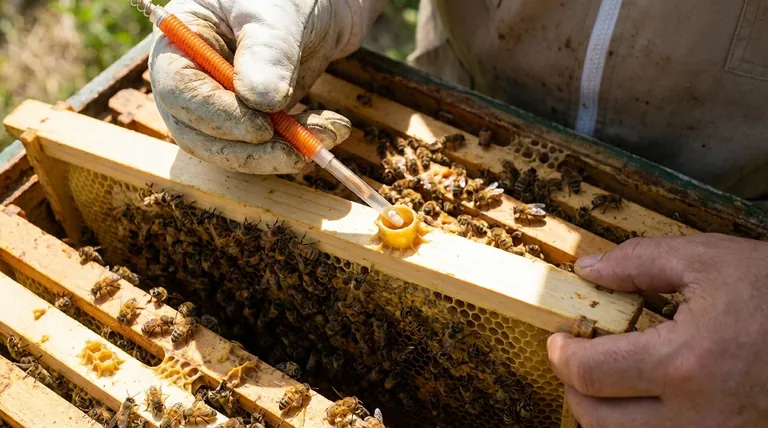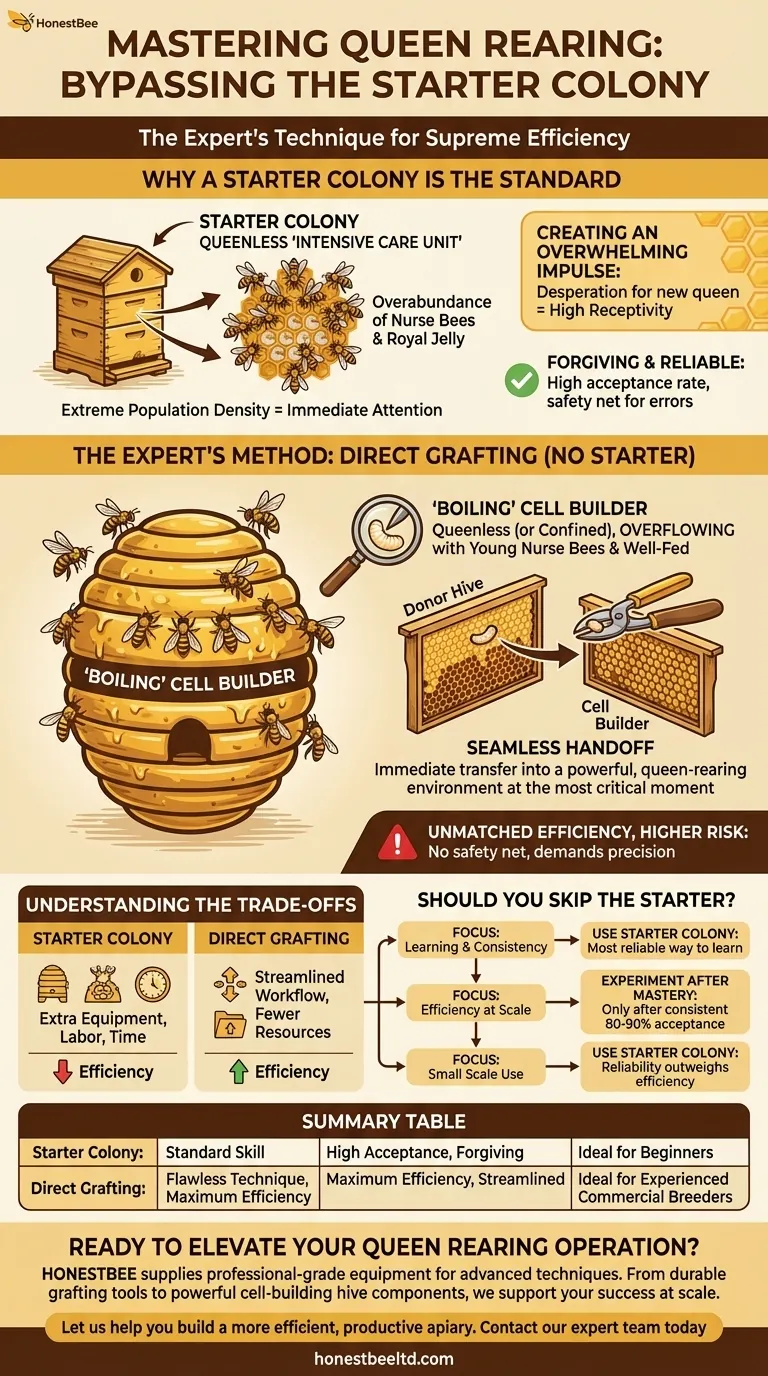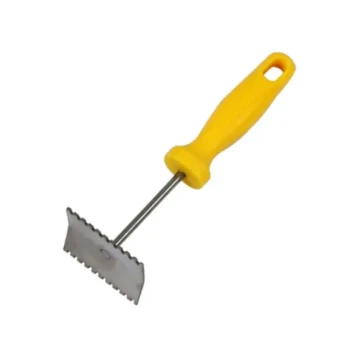For experienced queen breeders, the separate starter colony is often an unnecessary step. They bypass this process by grafting larvae directly into a meticulously prepared and powerful cell-building colony, relying on their refined technique and the colony's overwhelming impulse to raise new queens to ensure a high acceptance rate.
The ability to skip a starter colony is not a different technique, but a testament to mastery over the fundamentals. It trades the safety net of a starter for supreme efficiency, a trade-off that only works when both the beekeeper's skill and the colony's condition are flawless.

Why a Starter Colony is the Standard
To understand why skipping the starter is significant, we must first appreciate its purpose. It's a specialized tool designed to maximize the acceptance of delicate, newly-grafted larvae.
The Role of an "Intensive Care Unit"
A starter colony is essentially an "intensive care unit" for potential queens. It is a queenless, densely populated hive packed with an overabundance of young nurse bees.
This extreme population density ensures that grafted larvae are immediately attended to by numerous bees, who feed them copious amounts of royal jelly. This gives the fragile larvae the strongest possible start.
Creating an Overwhelming Impulse
The sudden and complete lack of a queen in the starter creates an emergency impulse. The bees are desperate to create a new queen, making them highly receptive to the grafted cells you provide.
The Expert's Method: Bypassing the Starter
Experienced breeders can replicate the intense conditions of a starter within their cell-building colony, making a separate starter redundant. This hinges on two critical factors: the graft itself and the state of the cell builder.
The Prerequisite: Flawless Grafting
The references mention confidence in "manipulative and grafting ability." This is the core of the method.
An expert works with incredible speed and gentleness. The larva is transferred without injury and with a small amount of its original royal jelly, and it is never allowed to dry out. A perfect graft placed directly into a strong cell builder is more likely to be accepted than a mediocre graft placed into a starter.
The Secret Weapon: A "Boiling" Cell Builder
A cell-building colony used for this direct method is not an average hive. It has been carefully managed to be in a state of peak readiness.
This means it is queenless (or the queen is securely confined to a lower box) and absolutely overflowing with young nurse bees. The colony must also be extremely well-fed with both pollen and nectar (or syrup) to stimulate wax production and the royal jelly glands of the nurse bees.
The Seamless Handoff
When an expert grafts directly into a cell builder, the transfer is immediate. The frame of grafted cells is moved from the donor hive to the cell builder in minutes.
This seamless transition minimizes stress on the larvae and places them into that powerful, queen-rearing environment at the most critical moment.
Understanding the Trade-offs
Skipping the starter colony is a high-level technique that prioritizes efficiency but demands precision.
The Benefit: Unmatched Efficiency
For a commercial queen breeder, managing separate starter colonies requires extra equipment, labor, and time. Integrating the starting phase directly into the cell builder streamlines the entire workflow, saving valuable resources.
The Risk: A Lower Margin for Error
A dedicated starter colony is forgiving. It can compensate for a slightly delayed graft or a less-than-perfect transfer.
When grafting directly into a cell builder, there is no such safety net. Any weakness in the colony's preparation, any flaw in the grafting technique, or any delay in the transfer will result in a significantly lower acceptance rate.
Should You Skip the Starter Colony?
Your decision should be based entirely on your current skill level and operational goals.
- If your primary focus is learning and consistency: Use a dedicated starter colony. It is the most reliable way to learn the process and achieve high acceptance rates as you build your skills.
- If your primary focus is maximizing efficiency at scale: Experiment with this method only after you have consistently achieved 80-90% acceptance rates using a starter.
- If your primary focus is a small number of queens for your own use: The reliability of the starter method far outweighs the small efficiency gain of skipping it.
Ultimately, mastering the fundamentals of grafting and colony management is what makes any method successful.
Summary Table:
| Method | Key Requirement | Primary Benefit | Ideal For |
|---|---|---|---|
| Starter Colony | Standard grafting skill | High acceptance rate, forgiving | Beginners, consistency-focused beekeepers |
| Direct Grafting (No Starter) | Flawless technique, 'boiling' cell builder | Maximum efficiency, streamlined workflow | Experienced, commercial-scale breeders |
Ready to Elevate Your Queen Rearing Operation?
As a commercial queen breeder or beekeeping equipment distributor, efficiency and reliability are paramount. HONESTBEE supplies the professional-grade beekeeping supplies and equipment you need to master advanced techniques like direct grafting. From durable grafting tools to powerful cell-building hive components, our wholesale-focused operations are designed to support your success at scale.
Let us help you build a more efficient, productive apiary. Contact our expert team today to discuss your specific needs and discover how our products can enhance your queen breeding results.
Visual Guide

Related Products
- Retractable Chinese Queen Rearing Grafting Tools Equipment
- Plastic Chinese Queen Grafting Tool for Bee Queen Rearing
- No Grafting Queen Rearing Kit: System for Royal Jelly Production and Queen Rearing
- Brown Nicot Queen Cell Cups for Breeding Queen Bees Beekeeping
- JZBZ Push-In Queen Cell Cups for Beekeeping
People Also Ask
- How should the frame of larvae be prepared for grafting? A Guide to Maximizing Larval Survival
- What is the Doolittle method of queen rearing? Master Controlled Queen Production for Your Apiary
- What are the key steps in the grafting technique? Master Queen Rearing for a Thriving Apiary
- What characteristics make larvae suitable for grafting? Select the Perfect Larva for Queen Rearing
- What is the purpose of grafting in queen bee production? Scale Your Apiary with Superior Genetics


















